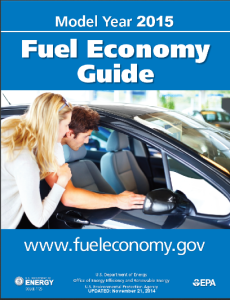 The US Department of Energy has a website www.FuelEconomy.gov that offers some great tips to improve your fuel economy and save money on gasoline.
The US Department of Energy has a website www.FuelEconomy.gov that offers some great tips to improve your fuel economy and save money on gasoline.
Drive More Efficiently
• Aggressive driving (speeding and rapid acceleration/braking) can lower your gas mileage by as much as 33% at highway speeds and 5% around town. Driver feedback devices can help you drive more efficiently, improving fuel economy by up to 10%.
• Observe the speed limit. Each 5 MPH you drive over 60 MPH can reduce your fuel economy by 7%. For a personalized estimate of the effect of speeding on your fuel economy, visit www.fueleconomy.gov
• Avoid idling. Idling gets 0 miles per gallon and costs as much as $0.04 per minute.
• Using cruise control on the highway helps you maintain a constant speed and, in most cases, will save gas.
• Using the air conditioner is more fuel efficient on the highway than opening the windows.
• Park in the shade so your car doesn’t get as hot.
• Leave the windows open when you first start driving to clear hot air out of the cabin.
Keep Your Car in Shape
• Fixing a car that is noticeably out of tune can improve your gas mileage by about 4%.
• Keeping tires inflated to the recommended pressure and using the recommended grade of motor oil can improve fuel economy by up to 5%. The manufacturer’s recommended tire pressure can be found on the tire information placard and/or vehicle certification label located on the vehicle door edge, doorpost, glove-box door, or inside the trunk lid.
• Keep your tires aligned and balanced.
• Replacing a clogged air filter can improve gas mileage on older cars with carbureted engines.
Plan and Combine Trips
• A warmed-up engine is more fuelefficient than a cold one. Many short trips taken from a cold start can use twice as much fuel as one multipurpose trip covering the same distance. Note: Letting your car idle to warm up doesn’t help your fuel economy; it actually uses more fuel and creates more pollution.
Other Solutions
• Avoid carrying unneeded items. An extra 100 pounds can decrease fuel economy by 1%–2%.
• Avoid carrying cargo on your roof. A large, blunt roof-top cargo box, for example, can reduce fuel economy by 2%–8% in city driving, 6%–17% on the highway, and 10%–25% at Interstate speeds (65 mph to 75 mph). Rear-mount cargo boxes or trays reduce fuel economy by much less—1%–2% in city driving and 1%–5% on the highway.
• Use the “economy mode” feature if your vehicle has one.
For more tips on improving fuel economy, such as cold-weather tips, hot-weather tips, and tips for hybrids, plug-in hybrids, and all-electric vehicles, visit www.fueleconomy.gov
Search TeenAuto
Socialize with Us
Like us on FacebookFollow us on TwitterWatch our Channel